
Fig. 1. Vegetation treatment process flow diagram.
Minal D. Pagedar, Dr. David A. Rockstraw
Dept. of
Chemical Engineering
New Mexico State University.
ABSTRACT
HALF LIVEs has developed a complete processing solution to the remediation problem posed by Task 3 of the 1996 WERC Design Problem. The team's goal to minimize the additional use of chemicals and not generate additional waste resulted in a unique desig. Size reduction of vegetation is an important feature for enhanced heat and mass transfer for the removal of contaminants. Steam is used to strip the radionuclides of highly soluble salts through percolation down the column. Continuous percolation of steam aides in decontamination and concentrating the salts in reboiler. Composting of the decontaminated flora converts the organic matter to CO2 and a valuable horticultural amendment or a stable landfill cover. The test results showed only 1.09 mg/Kg of Cs and 272 mg/Kg of Sr in the treated flora.
INTRODUCTION
The process design, as illustrated in Fig. 1, involves four steps: (1. harvesting and initial size reduction, (2. final size reduction with control of airborne particulate, (3. radionuclide removal, and (4. treated flora composting. The products of the processing are: (i) a container (~55 gallons) of radioactive materials in water, and (ii) a composted mass suitable for land application. Technical details, economics, regulatory issues and implementation plan for the process are discussed in detail below.

Fig. 1. Vegetation
treatment process flow diagram.
Process Design
The design of the complete processing facility is based on the four steps defined above. The plant site is adjacent to the site of the seepage basin. This would be the ideal arrangement to reduce the need for extensive highway transport of the harvested materials. The perimeter of the facility will be secured by a fence.
Flora Harvester
The principle harvester design specifications are as follows; (i) the harvesting procedure must afford the maximum worker protection possible in the spirit of ALARA, (ii) the vegetation must be in a physically controllable form when leaving the contaminated site, and (iii) the process must be economically feasible. In addressing these issues, attention was focused on the immediate hazard created due to the mobility of contaminated vegetation and brush. A small mechanical system mounted on a mobile platform and capable of harvesting the majority of the detached vegetation offered a practical solution to the above requirements. Worker exposure is reduced through less contact time with, and increased distance from the vegetation. A containment vessel may be easily incorporated into the mobile platform to retain the harvested vegetation. Finally, research revealed that an existing design concept for a harvester could be modified for this task. With this design, slight modification would be needed in order that a commercial utility vehicle may serve as the mobile platform.
Harvester Design
HALF LIVEs achieve mobility of the harvesting system by mounting vegetation gathering and volume reduction devices on a conventional utility truck. A drawing of the configuration is given in Fig. 2.

Fig. 2. Harvester
mounted on utility vehicle.
Two vertical. counter-rotating cylinders are mounted on a frame (similar to a snow plow mount) fitted to the front of the vehicle. Steel spring harvesting fingers are attached to each of these cylinders. As the cylinders rotate inward, these fingers collect loose vegetation and feed it to the rear of the collector. A modified commercial wood chipper/shredder is positioned directly behind the collector to shred the vegetation, reducing it to a form suitable for further processing.
The vehicles auxiliary hydraulic system powers the collector and chipper. The integral blower propels the product to the rear of the vehicle. A wire screen located between the chipper/shredder and the blower limits the final particle size. Large particles remain in the chipper until they are small enough to pass through the screen. Product of acceptable size is transported through a duct to a holding bin in the rear of the vehicle. The minimum particle size resulting from the harvester unit is limited to prevent airborne contamination. Secondary size reduction is performed in a controlled environment before the chemical treatment step.
The collector is capable of harvesting loose vegetation with a major stalk diameter of up to 1 inch. Thus, it is possible for a single worker to harvest the majority of detached foliage quickly and effectively.
Conventional methods (i.e., manual) are used to collect larger vegetation and attached bushes. Bulky vegetation is trimmed and the smaller branches are fed to the collector. Commercial chipper/shredders often feature a separate feed chute for such larger objects. The units that are of a suitable size for this application are able to shred trees with diameters of 6 inches or more. Based on advertised specifications of one such chipper/shredder HALF LIVEs estimate a maximum process rate of 16 yd3/hr. Commercial rotary arm and blade brush cutters are used for shredding larger diameter trees. These units are adaptable to most makes of backhoes and are able to shred very large diameter trees. They are preferred over hand held saws in that they decrease the direct contact time of personnel. In addition, they produce fairly large sized particles reducing the risk of respirable contamination. Feeding the debris from these cutters through the chipper/shredder accomplishes further size reduction.
Vegetation Processing Unit
Based on supplied radiation level data, there are an estimated 5-60 grams of radioactive species present in the vegetation. HALF LIVEs selected a unit able to process large volumes of vegetation without creating liquid waste or additional chemical by-products. The unit allows processing to continue for long periods before there is a need to remove the captured radioactive products.
Percolating Column
The processing unit is illustrated in Fig. 3. The flora (contained in loading cells) is placed in a percolating column. The loading cells are designed such that they have an annular region that contains the flora to be treated, and a pipe through the center that creates a path for steam travel to occur from the reboiler to the top of the percolation bed. The top and bottom plates of the loading cells are distribution plates, designed to provide for redistribution of the liquid condensate over the vegetation beds. The bottom of each loading cell has supports preventing it from resting directly on the top plate of the cell beneath (to prevent blockage of liquid flow through the column).
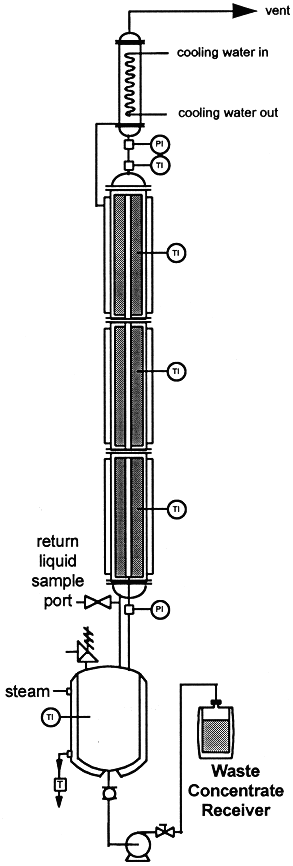
Fig. 3. Processing
column operation.
At start-up, vapor from the reboiler travels to the top of the column through the percolating pipe that runs through the center of each loading cell. The vapor then condenses onto the packed vegetation bed. As the condensate trickles down through the packed bed of vegetation, the highly water soluble radioactive chlorides are transported down the column in the direction of the reboiler. The extracting effect of the condensate moving down through the column is enhanced by heat from the percolating pipe in the center of the column. The heat causes a refluxing of the condensate increasing the time a given volume of water spends in the column. This effect increases the amount of contaminated vegetation a given quantity of water will contact, thus increasing the salt concentration of the liquid returning to the reboiler.
The column operation can therefore be likened to a pressurized, percolating coffee pot (with the exception that clean, condensed reboiler vapor rather than contaminated reboiler liquid is used as the percolating liquid), with the solution in the reboiler becoming an increasingly stronger brew. The extraction rate of the chlorides will be a function of (i) flow rate of condensate through the column, (ii) temperature of the steam/condensate moving through the column (fixed by the column operating pressure), (iii) mass transfer effects between the water, flora and salts, and (iv) physical properties of the system, including the diffusivity of water in the vegetation and the solubility of the radioactive salts in the boiling water.
With mass transfer controlling batch cycle time, it is advantageous to reduce the vegetation particle to a smaller size than that obtained from the harvester. Such an operation requires special consideration of particle containment to assure potentially dangerous airbornes are suppressed.
HALFLIVEs will therefore perform the final size reduction in a controlled environment. Commercially available grinding equipment may be modified and operated remotely and without operator intervention. The grinder is fed from a chute that leads external to the facility. Ground product is fed pneumatically to the loading cells. The entire final size reduction operation will take place in a cinder block containment cell, equipped with an HVAC system to suppress any airborne particulates that are generated by the equipment.
Monitoring and Control of the Column
The extraction process is monitored off-line by sampling and analysis of the condensate return to the reboiler. A batch is complete when the measured radioactivity is an acceptable level. Upon completing a batch, the column is opened from the top, and a hoist is used to remove the loading cells containing the decontaminated vegetation. Cells containing radioactive vegetation are subsequently placed in the column for the next batch. The wet, decontaminated vegetation is removed to the composting site (described in the following section) for final volume reduction. At the onset, the reboiler will contain sufficient water to dissolve all of the radioactive salts present in the 40,000 yds3 of vegetation as well as inventory the column system with vapor. Thus, the liquid contents need not be discharged during the operation. Upon completion of the processing of all the flora (or when operating conditions warrant), the liquid in the reboiler can then be boiled down, recovering the water overhead, and further reducing the volume of material ultimately requiring disposal. HALFLIVEs anticipates that the final disposal volume of the radioactive salts is that of a 55-gallon drum. Such a drum shall be constructed of materials able to shield the final radioactivity level of 50-65 Curies Cs-137 and 60-3800 Curies Sr-90. The shield design will be based on 80 R/hr from Cs-137. In addition, the shield design will incorporate a plastic barrier to reduce photon exposure from Bremsstrahlung radiation due to Sr-90 beta emissions. Final disposal is addressed in Legal, Health and Regulatory Considerations.
Vegetation Composting
Wet material and organic materials can cause problems in landfills. To expand the options for ultimate disposal, the decontaminated vegetation will be dried, reduced in mass, and stabilized in a composting system. Composting is an aerobic biodegradation process that converts organic matter into carbon dioxide and a valuable horticultural amendment or stable landfill cover. The physical and chemical processing in the HALF LIVE's treatment train renders the carbon in the vegetation more readily available to microorganisms. Nutrients (nitrogen and phosphorus) will be added to create an environment conducive to the proliferation of the appropriate aerobic composting microorganisms. To increase the rate of composting, a population of acclimated organisms will be maintained with finished compost recycle. Uncontaminated soil, locally available compost, or manure will be mixed with the first batch to enhance the microbial population.
An agitated bay composting system has been selected over a low tech windrow composting system because of it's advantages: (I) improved process control, (ii) increased rate of composting, (iii) minimization of labor costs, and (iv) greater public acceptance. Six concrete channels 8' x 80' x 10' deep, equipped with two high speed flail agitators on rails comprise three parallel treatment trains. The system will operate in batch mode with a detention time of 40 days. Approximately 30 cubic yards of vegetation will be emptied out of the loading cells into a composting channel prepared with 10 cubic yards of finished compost. Nitrogen and phosphorus will be added through a liquid delivery system that will also be used to recycle leachate and add water during composting. Moisture content will be managed for an optimum 55 percent during composting and 30 to 40 percent in the product. The agitator will mix the contents of the channel when it is filled and once every four to seven days thereafter for aeration and decompaction. Odors are not usually experienced during wood composting and due to expected distance from populated areas, no offgas treatment is required. Screening in not required due to the purity and preprocessing of the feedstocks and absence of commercial marketing constraints.
Material Balance
A material balance performed for the process is provided below in Table I. Column products are those flows that are not passed on to the composter. Water vapor refers to that water that is boiled off the vessel for volume reduction prior to the final waste product drumming, or is lost to the atmosphere in composting.
TABLE I Process Material Balance

PROTOTYPE CONSTRUCTION
Flora Harvester
The mobile harvester concept is currently being explored by the New Mexico State University Mechanical Engineering Department. The purpose of this project is to gather and reduce the volume of stray tumbleweeds for the New Mexico State Highway Department. The proof of concept for the WERC task uses a demonstrated prototype from this project. Two major sub- assemblies, the collector and the chipper/shredder/blower, comprise the prototype. These sub-assemblies are mounted on a common frame and connected by ductwork, as shown in Fig. 4.
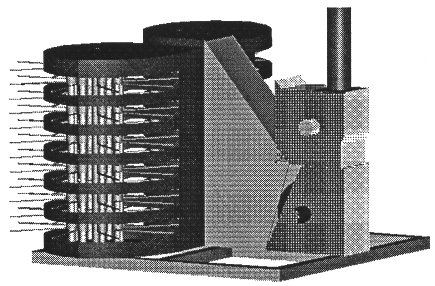
Fig. 4. Mobile
harvester's collector sub-assembly.
Collector
The collector assembly includes the two rotating drums, the steel spring fingers, the containment shroud, and a mounting frame. Each drum is assembled using eight equal lengths of 1Þ" diameter, 11-gauge steel pipe placed around the circumference of two circular, 3/16" thick steel endplates. A total of 96 spring fingers are mounted radially on the pipes. The overall height is about 4 feet. A 1" diameter cold rolled round rod serves as the axle. Hydraulic motors atop each of these shafts providing rotary motion. Strips of flat stock which comb the fingers are wrapped around the cylinders. They are attached to the frame and prevent the vegetation from becoming entangled inside the drums. The frame is constructed of 3" x ¼" extruded channel stock.
Chipper/Shredder/Blower
The chipper/shredder/blower, shown on the right-hand side of Fig. 1is a slightly modified commercial design. The blower is mounted on top of it. A 20 hp internal combustion engine powers both units. The entire harvester assembly requires about 50 hp, 2300 psi at 30 GPM.
Chemical Processing Unit
Differences between the contamination level of the actual flora and the much higher levels stated to be in the supplied samples allowed HALFLIVEs to design a simple, on-line monitoring technique for the prototype. A secondary reboiler was added allowing measurement of the boiling temperature of the condensate leaving the column. The boiling point temperature is a colligative property of a solution, and is a linear function of the salt concentration. Thus, the approximate concentration of the chloride species exiting the column can be determined by a knowledge of the boiling-point elevation constant. When the temperature in the secondary reboiler returns to that of pure water at the operating pressure (1 atm for this unit), the chlorides in the vegetation bed are then known to be removed. The level in this unit is maintained by a spillway that returns the condensate to the primary reboiler (see Fig. 5).
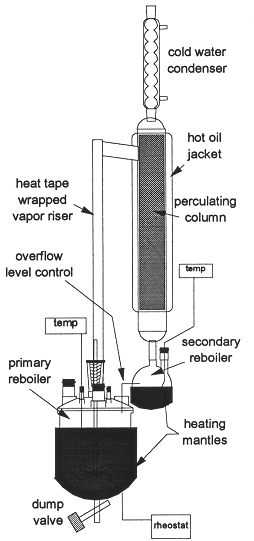
Fig.5. Prototype
percolator
A second major difference between the prototype and the proposed commercial unit is due to the relatively small size of the prototype column diameter that precludes operation with an internal percolator. Thus, the steam riser was located external to the vegetation bed. To maintain the steam riser temperature and thereby allow the vapor to rise to the top of the column, the riser was wrapped with heat tape and set to maintain the glass tube walls at 100°C. The prototype percolating bed was jacketed with hot oil rather than insulated. This is to allow for visual inspection of the condensate flow pattern.
In the prototype version, the final size reduction facility is simulated using an ordinary kitchen blender.
TEST METHODS
Vegetation Harvester
A test was conducted using a commercial chipper/shredder to determine typical particle size of processed fresh vegetation. The chipper/shredder was rated to process limbs up to 3" in diameter. The feed for the test consisted of freshly cut pine branches varying from 1 to 4 cm in diameter, mesquite wood to simulate hardwood, and various brushes. The wood types were processed separately and then combined to form a mixture of approximately 60% pine, 20% mesquite and 20% brush by volume. A qualitative summary of the test results is given in Table II.
TABLE II Results of Particle Size Test Using
Commercial Chipper/Shredder

Each type of vegetation was processed through the chipper/shredder multiple times. HALF LIVEs found that in the case of the mesquite and brush, multiple passes had little effect on particle size. After a single pass, some of the pine wood remained in fairly large chunks. After a second pass, these pieces were reduced to approximately the same size as the processed mesquite wood. In all cases little difference was noted in size after further runs.
Chemical Processing Unit
The boiling point of CsCl and SrCl2 solutions were measured at expected secondary reboiler salt concentrations. These data are used to calculate the boiling-point elevation constant for the salts. The boiling point elevation is then used to monitor the extent of salt extraction from the prototype column. HALF LIVEs stops the extraction when the boiling point of water in the secondary reboiler reaches the boiling point of pure water (or the baseline temperature determined by control runs made of vegetation in the absence of added salts), an indication all salts have been removed.
Using vegetation of known contaminate concentration prepared from harvester-treated woods and grasses, test runs of the prototype column were made. Recovery yields of salt were determined by: (1. boiling off the water in the reboiler, (2. draining the heel of aqueous liquid remaining in the vessel, (3. drying the heel to remove the remaining water, and (4. weighing the remaining solids. The solids are then slurried with an organic solvent to remove any dirts and organic materials from the extraction process, and then redried to obtain a "recovered" mass of chlorides. This mass is used to calculate the recovered yield.
Composting Unit
Processed vegetation "cooked" in deionized water at 105°C for 4 days and was mixed with manure and cotton waste compost, urea, and phosphate at approximately 100%, 1%, and 0.3% respectively. One liter of the mixture was composted in a benchscale reactor for 14 days. The material was removed and mixed every 5 days to simulate the agitation in the full sale system. The temperature at the center of the reactor averaged 23°C (73°F) indicating that low rate composting was maintained throughout the experiment.
The changes in mass, moisture content, and volume after 14 days of composting are shown in Table III. The 12% loss in dry weight can be attributed to a loss of vegetative mass since the compost amendment was well aged and not susceptible to degradation over this time period. The material was not a finished compost after 14 days. Therefore 40 days is recommended for the full scale system.
TABLE III Results of Benchscale Composting of
Processed Vegetation

ASSESSMENTS
Technical
Eacu unit of the remediation process is based on proven technologies that should offer few unforeseen obstacles in implementation. The harvesting process modifies existing designs for vegetation gathering and primary volume reduction, while addressing the unique problems associated with radioactive contamination. The primary objective in this process is reduced worker exposure via speed and distance. The modular design provides for easy removal from the vehicle when transporting product to the treatment facility, or for periodic decontamination should residual radiation levels become unacceptable.
The approach to radionuclide separation and isolation, though energy intensive, provides the maximum volume reduction of the radioactive materials possible. Pilot data is needed to determine the actual mass of vegetation that can be processed before shutdown is required for clean-outs due to fouling.
Composting is an effective and publicly acceptable method of achieving mass reduction, stabilization, and drying of the decontaminated flora from the treatment process. A detention time of 40 days with mechanical agitation will achieve approximately 30% reduction in mass and volume.
ECONOMIC
Table IV is a cost estimate for production of the mobile harvester unit. The estimate is based on modifying the existing design production for application to Task 3. Costs are on a per unit basis, with each unit able to process an average of 8.0 yd3/hr of vegetation. The rotary brush cutting head for large vegetation is an additional cost. Commercial units cost about $30,000 each, including all mounting hardware. Costs of any utility vehicles (e.g., dump trucks and backhoes) are not included in this summary.
TABLE IV Cost Estimate for Manufacture of Single
Harvester Unit
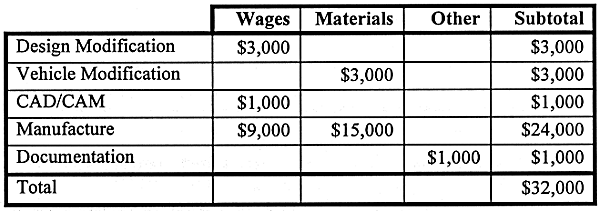
The size, processing rate and cost estimation of the percolating column and associated units were selected using a weighted average density of material densities from the literature.(3)(hardwoods, 45 lb/ft3; softwoods, 32 lb/ft3; grasses, 22 lb/ft3; mixture, 33 lb/ft3). The total weight of the 40,000 yd3 of "solid" vegetation [i.e., initial porosity = 0, per Abbas Ghassemi] thus has a total weight of 35 million pounds. The final form of the flora (after size reduction) is assumed to have a porosity of 25%.
Costs associated with the vegetation processing unit are summarized in Table V. The capital costs are a function of the column size. The total project cost (capital and operating) for the percolating column was optimized based on the volume of the column. Processing costs for the percolating column are about $0.63/lb of vegetation treated.
TABLE V Cost Estimation for Percolating System
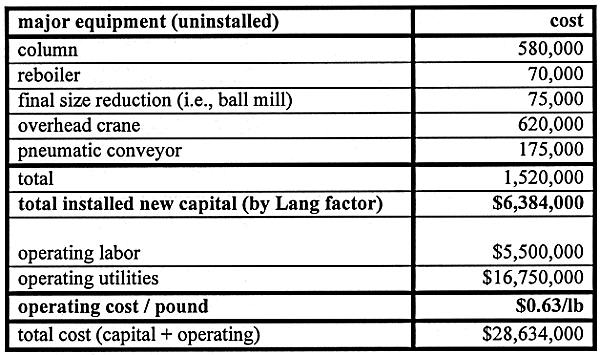
Capital costs associated with the column were estimated by standard techniques. (4) based on the weight of the column. Purchased costs of the other major units (reboiler, grinder, pneumatic conveyor and crane) were estimated and Lang factors were applied to estimate the installed capital investment. Capital cost is sensitive to operating pressure (shell thickness, thus weight is proportional to internal pressure). An operating pressure of 100 psig was selected for the purpose of this analysis.
Operating costs were estimated assuming the turn-over time necessary to empty and reload the column dominates the variable costs and thus favors larger column sizes (utility costs are constant in this analysis since the weight of material to process is fixed). Turn-over labor was assumed to be contracted. The wages of the contract operators working turn-over shifts are paid only during column turn-over. The analysis assumed $25/hr wages paid to shifts of 4 operators and a team of 10 contractors. One shift crew is present at the site 24hr/day. The contract team works 10 hour days during turn-over to replace the vegetation contents of the column. Batch cycle time was estimated as a function of batch size. For the optimum design (Fig. 6), turn-over accounts for 50% of operations time. Total operation requires 3Þ years. The optimized result (using an incremental capital investment) is a column 150' tall and 10' in diameter.
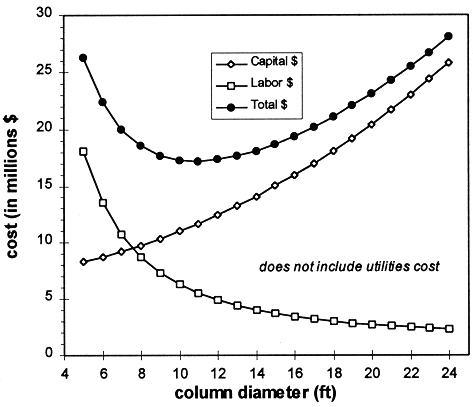
Fig. 6. Optimization
of project cost.
Utility costs dominate the direct costs of the percolating column operation. However, the utilities costs are roughly proportional to the fixed mass of vegetation being treated, and therefore did not contribute to the optimization between capital and direct costs and could therefore be determined separately. HALFLIVEs assumed for the calculation that one pound of water would have to be vaporized for every four pounds of vegetation being treated. With proper insulating and heat recovery from the vapor riser, it is expected that this ratio will allow the mass to be contacted by 16 lb of steam per lb of flora.
The composting bays will be located on a paved acre. Table VI contains the capital costs for the agitated bay composting system.
TABLE VI Capital Cost of the Agitated Bay Composting
System

Total fixed capital investment is found by summing the capital of the three steps, and amounts to about $6.8 million,
BUSINESS PLAN TO ENSURE LEGAL, HEALTH AND REGULATORY COMPLIANCE
Compliance with Documentation and Permitting Requirements
Though the process is not directly subject to the regulation, HALF LIVEs intend to operate under the philosophies presented by the Process Safety Management (PSM) of Highly Hazardous Chemicals Regulations of 29 CFR 1910.119. HALF LIVEs will develop the necessary documentation under the 1910.119 regulation, including: (i) start-up, shutdown, normal and emergency operating procedures, (ii) a Chemical Hygiene Plan, (iii) a Respiratory Protection Program and (iv) a Hazards Communication Program. Each document will be based on the technical aspects discussed in this report, and on the regulatory information below. Employees will be trained in the content of these documents prior to being allowed to operate any part of the facility. The unit will undergo thorough process hazards review using the industrially accepted practices of Hazards and Operability (HAZOP) and Fault Tree Analysis.
The decontaminated vegetation is a non-radioactive material and therefore the composting area will be isolated from the radioactive processing areas of the facility. Wood waste composting is not federally regulated in the United States. State regulations may require composting facilities to be permitted under solid waste management regulations. Some exemptions exist for on-site generator composting. Final disposition of the compost product as a soil amendment or landfill cover, and all operating procedures will be permitted and documented as required by local regulations.
Compliance with Chemical Hazards Regulations
The chemical reactivity hazards of CsCl and SrCl2 are low compared to many industrially handled materials. Both materials are chemically stable under normal temperature and pressure. None of the known SrCl2 and CsCl in compatibles will be present at the processing site.
HALF LIVEs will comply with all the Occupational Safety and Health Administration (OSHA) regulations set forth by 29 CFR. These materials are not listed by ACGIH, IARC, NIOSH, NTP or OSHA as carcinogens. Information is unavailable on the chronic chemical effects of cesium chloride but strontium chloride causes chronic adverse reproductive effects on prolonged exposure (teratogin). Both salts are skin and eye irritants. All employees will wear appropriate personnal protective equipment. Respirators will be worn as per 29 CFR 1010.134. Details of the appropriate procedures and they required protective equipment will be included in the operating procedures and Respiratory Protection Program.
Compliance with Radiation Hazard Regulations
HALF LIVEs will follow regulations regarding threshold limits of radioactive cesium and strontium in air and water contained in 10 CFR, Appendix B, 20.1-20.601. The permissible doses, levels and concentrations for individuals working in the restricted area indicated by 10 CFR 20.101 will be met by implementation of a radiation hygiene program. Accidents and over exposures to radiation will be reported to U.S. Nuclear Regulatory Commission as soon as possible, but not later than 4 hours after the discovery of an event that prevents immediate protective actions to avoid exposures to radioactive materials that exceed regulatory limits as laid down by 10 CFR 30.50. Under the PSM standards, an emergency procedure will be developed for each such identifiable incident.
Records of all the radioactive materials will be maintained as per the requirements of 10 CFR 20.101. Quality control sampling tests will be performed and licenses will be renewed as per 10 CFR 32.110.
A site specific study will be conducted to determine the health risks associated with the harvesting procedure. The study will focus on maximum personnel dose rates based on the distribution of radionuclide concentrations. A computer modeling tool will be used in conjunction with discrete measurements to determine the concentration distribution. Although many such models are still in developmental stages, they have shown success in predicting the overall features of radionuclide distribution in ecosystems where measurements have been taken.(5) The study will also examine the likelihood of respirable airborne particles created during the proposed harvesting procedures. These tests will examine the product created when a commercial rotary brush cutter is applied to representative vegetation. Based on the results of this study, an optimum balance between the use of personal protection gear and worker speed and agility will be obtained. It will be ensured that the result of this compromise will comply with all federal, state, and local statues and regulations.
HALF LIVEs will comply with radioactive material exposure regulations set forth by 29 CFR 1910.96 (Ionizing Radiation). A "radioactive materials safety manual" will be kept at the processing site and all items used for radioactive purposes at the work site will be labeled with "Caution-Radioactive Material" signs or stickers. Radiation symbols will be placed on all potential radioactive emission sources. Personnel dosimeters will be provided for all the employees whose duties involve working directly with radioactive materials at the work site to evaluate the level of exposure to radiation.
Work physically performed on a DoE site would follow the 10 CFR 835 regulations, with release limits based on the proposed regulations of 10 CFR 834.
Compliance with Department of Transportation (DOT) Regulations
HALF LIVEs will follow the packaging and transportation regulations of radioactive materials (cesium and strontium) as laid down in 10 CFR Part 71. Packaging requirements for radioactive materials must be calculated and packed accordingly as per 49 CFR 173.401 through 173.478. Storage requirements that address these chemicals as radioactive materials have to be met as per 10 CFR 72.1 through 72.240.
Community Action Plan
The three ethics involved in the community action plan and environmental planning are: (i) to serve public interest, (ii) to recognize the comprehensive nature of planning decisions and (iii) to maintain public confidence. Environmental planning involves making decisions on issues that usually have significant long term effects and yet these effects are hard to comprehend for many people, particularly for those used to having immediate results. The community action plan will educate the people near the site of operation on the importance of the environmental endeavor being carried out by the organization. The community action plan will include a description of the site background, history of community involvement at the site, community relation strategies, and a list of contacts, local officials ad interested parties. Means of obtaining public feedback on the project shall be discussed. A committee will be formed to take care of actions leading to bettering community relations.
CONCLUSIONS
The treatment system designed and tested for the harvesting, radionuclide separation and vegetation composting of contaminated flora from a seepage basin was found to be an efficient and cost effective technique, from a technical perspective as well as a personnel safety viewpoint. Treatment costs of under $1/lb for 35 million pounds of radioactive flora and less than $10 million in capital investment are acceptable costs for the elimination of the described ecological threat to nearby communities. A more detailed design of the process should begin immediately.
REFERENCES
NMSU FACULTY ADVISORS
| Edgar G. Conley Associate Professor Mechanical Engineering |
Dr. Dana O. Porter Assistant Professor Agricultural Engineering |
Dr. David A. Rockstraw Assistant Professor Chemical Engineering |